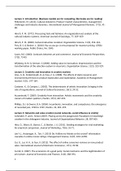Lecture 1: Introduction: (Business models are for competing, like books are for reading)
Peltoniemi, M. (2015), Cultural industries: Product–market characteristics, management
challenges and industry dynamics. International Journal of Management Reviews, 17(1), 41-
68.
Hirsch, P. M. (1972). Processing fads and fashions: An organization-set analysis of the
cultural industry systems. American Journal of Sociology, 77, 639–659.
Hirsch, P. M. (2000). Cultural industries revisited. Organization Science, 11(3), 356–361.
Frey, B. S. & Steiner, L. (2010): Pay as you go: A new proposal for museum pricing, CESifo
working paper, Public Choice, No. 3045.
Caves, R.E. (2003). Contracts between art and commerce. Journal of Economic Perspectives,
17(2), 73-83.
Wijnberg, N.M. & Gemser, G (2000). Adding value to innovation: Impressionism and the
transformation of the selection system in visual arts, Organization Science, 11(3), 323-329.
Lecture 2: Creativity and Innovation in creative markets
Voss, G. B., Sirdeshmukh, D. & Voss, Z. G. (2008). The effects of slack resources and
environmental threat on product exploration and exploitation, Academy of Management
Journal, 51(1), 147-164.
Castaner, X., & Campos, L. (2002). The determinants of artistic innovation: bringing in the
role of organizations, Journal of Cultural Economics, 26(1), 29-52.
Accominotti, F. (2009). Creativity from interaction: Artistic movements and the creativity
careers of modern painters, Poetics, 37(3), 267-294.
Phillips, D.J. & Owens, D.A. (2004). Incumbents, innovation, and competence: the emergence
of recorded jazz, 1920 to 1929, Poetics, 32, 281–295.
Lecture 3: Networks and value creation (social networks, social influence & virality)
Cohendet, P. and L. Simon (2007). Playing across the playground: Paradoxes in knowledge
creation in the videogame industry. Journal of Organizational Behavior, 28, 587-605.
Hinz, O., Skiera, B., Barrot, C., & Becker, J. U. (2011). Seeding strategies for viral marketing:
An empirical comparison. Journal of Marketing, 75(6), 55-71.
Lee Y.L., Hosanagar, K., Tan, Y. (2015) Do I follow my friends or the crowd? Information
cascades in online movie ratings. Management Science, 61(9), 2241-2258.
Cui, G., Lui, H. K., & Guo, X. (2012). The effect of online consumer reviews on new product
sales. International Journal of Electronic Commerce, 17(1), 39-58.
Currid, E. (2007). The economics of a good party: Social mechanics and the legitimization of
art/culture. Journal of Economics and Finance, 31(3), 386-394.
1
,Lecture 4: The return of fads and fashions
Salganik, M.J & Watts, D.J. (2008) Leading the herd astray: An experimental study of self-
fulfilling prophecies in an artificial cultural market, Social Psychology Quarterly, 71, 4: 338-
355.
De Groot, J.; Kackovic, M. & Wijnberg, N.M. (2019) Status in the organization and its effects
on cultural consumption, research paper (find it in Canvas page of the course)
Yoganarasimhan, H. (2012) Cloak or flaunt? The fashion dilemma. Marketing Science, 13(1),
74-95.
Gemser, G. & Wijnberg, N.M. (2001) Effects of reputational sanctions and inter-firm linkages
on competitive imitation, Organization Studies, 22(4), 563-591.
Lecture 5: Authenticity & Reality
Wei, J. (2012). Dealing with reality: Market demands, artistic integrity, and identity work in
reality television production, Poetics, 40(5), 444-466.
Beverland, M.B. & Farrely F.J. (2009). The quest for authenticity in consumption: Consumers’
purposive choice of authentic cues to shape experienced outcomes, Journal of Business
Research, 36, 838-856.
Ouellet, J.F., Savard, M.A., Colbert, F. (2008). The personality of performing art venues:
Developing a measurement scale, International Journal of Arts Management, 10(3), 49-59.
Mol, J.M. & Wijnberg, N.M. (2007). Competition, selection and rock & roll: the economics of
payola and authenticity. Journal of Economic Issues, 41(3), pp. 701-714.
Lecture 6: New product introductions and recommender systems
Kremp, P. (2010). Innovation and selection: Symphony orchestras and the construction of
the musical canon in the United States (1879–1959). Social Forces, 88(3), 1051-1082.
Krider, R. E., & Weinberg, C. B. (1998). Competitive dynamics and the introduction of new
products: The motion picture timing game. Journal of Marketing Research, 35(1), 1-15.
Elberse, A., & Eliashberg, J. (2003). Demand and supply dynamics for sequentially released
products in international markets: The case of motion pictures. Marketing Science, 22(3),
329- 354.
Koren, Y., Bell, R., & Volinsky, C. (2009). Matrix factorization techniques for recommender
systems. Computer, 42(8), 30-37.
Aguiar, L., & Waldfogel, J. (2018). Platforms, promotion, and product discovery: Evidence
from Spotify playlists (No. w24713). National Bureau of Economic Research, 1-42.
2
, WEEK 1 E-books
Article 1 Peltoniemi, M. (2015), Cultural industries: Product–market characteristics,
management challenges and industry dynamics.
This article is about cultural industries as systems. The purpose of the present paper is to
offer a reconceptualization of cultural industries by tracing their boundaries, their features
and the dynamics that follow from these features.
Cultural industries are those that produce experience goods with considerable creative
elements and aim these at the consumer market via mass distribution.
- Creative elements: stories and styles, and they serve the purposes of entertainment,
identity-building and social display.
- Mass distribution: storage and delivery where economies of scale play an important
role.
Two features specific to cultural industries
- A persistent oversupply of creative labour, which is independent of economic cycles.
For example, there are many more singers/actors/fashion designers than the markets
can support.
- An extreme uncertainty regarding the success potential of any specific product,
because consumer lack of information about the product.
This leads to overproduction where gatekeepers restricts the access of cultural
products to the audiences.
Three approaches
- The political economy of culture, concerned with how cultural production is financed
and organized, and the effects of this on power and social justice.
- Organizational, business and management studies on the specifics of cultural
production including innovation, organizational structures and the management of
creative labour.
- Cultural studies aiming to study popular culture as a social phenomenon.
Two type of selectors/gatekeepers
- Upstream selectors: the companies with whom creative artists make contracts
(recording labels, film studios) and who finance creative projects. These are the ones
who decide whether a product reaches completion.
- Downstream selectors: including media, retailers, charts, critics and award
committees. These are the ones that influence on whether a finished product reaches
an audience.
3




